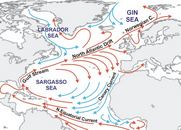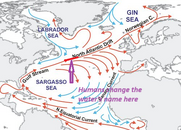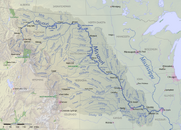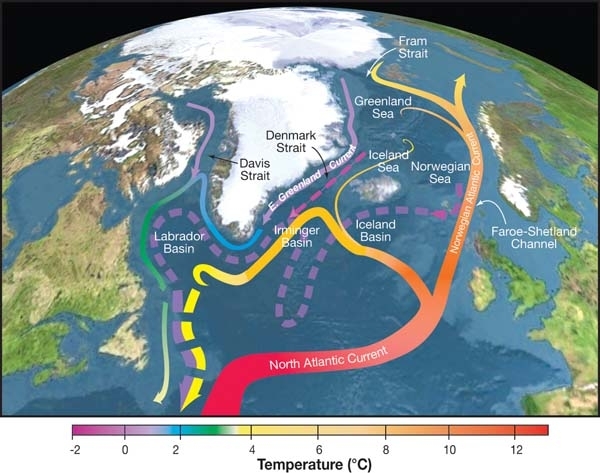No, not directly, but it does contribute, indirectly.
The issue is: the GS does NOT get to Europe, but the warmth from it -- transmitted primarily in the overlying atmosphere -- definitely does.
A common myth is that the Gulf Stream (GS) crosses the Atlantic and gets to the British Isles and Europe and keeps them warm.
This is NOT true, not matter how many times you may read it and see pictures like this:

The problem with that picture is it calls the entire ocean circulation across the Atlantic the GS. However, the Gulf Stream is a wind-stress-driven westward intensification that only gets east to the Grand Banks south of Newfoundland, and then peters out and feeds the Canary current going southeastward, and the North Atlantic Current (or Drift) going northeasterward. It is the latter -- driven by thermohaline processes (i,e, vertical circulation caused by warmer and colder, fresher and saltier water; i.e. NOT driven by westward wind stress).
A slightly better picture is this one:

and an even better picture is this one:

A very good article describing all this (NOT in the popular literature!) is:
The Wikipedia article is not bad; see the section on "Properties."
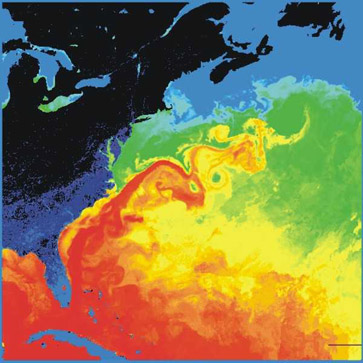
 en.wikipedia.org
en.wikipedia.org
If you want to read an entire book about it, see:

 www.ucpress.edu
www.ucpress.edu
The article in the Encyclopedia Brittanica says,
Here, from Gulf Stream - MeteoSwiss.:
I'm sure many of you will read this and say you've looked at Google and seen the first picture above and so it must be true...the GS flows to Europe and keeps it warm.
Sorry.
The issue is: the GS does NOT get to Europe, but the warmth from it -- transmitted primarily in the overlying atmosphere -- definitely does.
A common myth is that the Gulf Stream (GS) crosses the Atlantic and gets to the British Isles and Europe and keeps them warm.
This is NOT true, not matter how many times you may read it and see pictures like this:
The problem with that picture is it calls the entire ocean circulation across the Atlantic the GS. However, the Gulf Stream is a wind-stress-driven westward intensification that only gets east to the Grand Banks south of Newfoundland, and then peters out and feeds the Canary current going southeastward, and the North Atlantic Current (or Drift) going northeasterward. It is the latter -- driven by thermohaline processes (i,e, vertical circulation caused by warmer and colder, fresher and saltier water; i.e. NOT driven by westward wind stress).
A slightly better picture is this one:
and an even better picture is this one:
A very good article describing all this (NOT in the popular literature!) is:
The Wikipedia article is not bad; see the section on "Properties."

Gulf Stream - Wikipedia
If you want to read an entire book about it, see:

The Gulf Stream
This title is part of UC Press's Voices Revived program, which commemorates University of California Press’s mission to seek out and cultivate the brightest minds and give them voice, reach, and impact. Drawing on a backlist dating to 1893, Voices Revived makes high-quality, peer-reviewed...
The article in the Encyclopedia Brittanica says,
"The main portion of the Gulf Stream continues north, veering more to the east and passing close to the Grand Banks, south of Newfoundland, where it breaks up into swirling currents. Some of these eddies flow toward the British Isles and the Norwegian seas and form the North Atlantic Current (or Drift). A larger number flow south and east, either becoming part of westward-flowing countercurrents or joining the Canary Current."
Here, from Gulf Stream - MeteoSwiss.:
"The Gulf Stream is part of two larger circulation systems in the North Atlantic: the AMOC and the North Atlantic Gyre. The Gulf Stream is largely driven by winds and only to a lesser extent by the density-driven AMOC. The AMOC is the current that is largely responsible for the warm climate in Europe and is often mistakenly equated with the Gulf Stream. The Gulf Stream transports around 90 million cubic metres of water per second (= 90 Sverdrup) eastwards. At around 15 Sverdrup, the AMOC accounts for only a small part of its volume. However, the AMOC turns northwards off Europe, while the continuation of the Gulf Stream, the North Atlantic Current, turns southwards. The AMOC releases a lot of heat into the atmosphere in the colder north and consequently warms (northern) Europe. The North Atlantic Current also transports most of the heat it brings along back to the south."
I'm sure many of you will read this and say you've looked at Google and seen the first picture above and so it must be true...the GS flows to Europe and keeps it warm.
Sorry.



